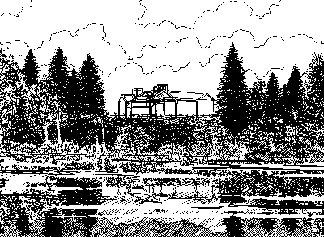In 1831, four Flathead Indians from The Oregon Country walked to St. Louis “seeking a book containing directions on how to conduct themselves in order to enjoy” the favor of “the Great Spirit.” Their story, told in a letter which appeared in The Christian Advocate and Journal, caused a sensation. In short order the Board of Missions of the Methodist Episcopal Church appointed the Rev. Jason Lee (1803-1845) Missionary to the Flathead Indians.
With a small party of co-workers, Lee traveled west with a fur trading expedition. Upon arrival in The Oregon Country in 1834, he established a mission on the Willamette River.
Lee set out to The Oregon Country dedicated to his spiritual task of taking the gospel to “the red men of the West.” But in the Willamette there were few to convert. The native population had been decimated by the white man’s diseases that had arrived earlier on sailing ships. Lee soon recognized that his mission was not to the rapidly disappearing Native Americans but to the United States settlers who were to immigrate to the area.
A second contingent of missionaries sailed to The Oregon Country via Cape Horn and Hawaii in 1837. They included several women, among them Anna Maria Pittman who soon became Mrs. Jason Lee.
In 1839, “The Great Reinforcement” sailed for Oregon. Never before had the Board of Missions sent out such a large contingent of missionaries. It included five preachers, four mechanics, four teachers, two farmers, an accountant, and their families. Among them were George Abernathy, The Oregon Country’s future first governor and Ira Babcock, who became Oregon’s first Supreme Judge.
Historically, the mission site has both spiritual and secular significance. The missionaries’ leadership in education, farming, and manufacturing made an important difference in Oregon’s social, cultural, and economic future. Lee’s support of United States ownership of The Oregon Country, ownership which was contested by Great Britain, made him an important early political figure as well.
In 1843, reports sent east to the Board from a disgruntled missionary prompted it to replace Lee with a new superintendent who dissolved the mission and sold its property, an action the Board later regretted.
Jason Lee spent less than ten years in The Oregon Country and died before this area became The Oregon Territory in 1848. Today there are statues of Lee on the Oregon State Capitol grounds and in Statuary Hall in the United States Capitol.
Points of interest at this Heritage Landmark: This landmark marks the site where in 1843, Rev. Jason Lee established Willamette Mission, the place where U.S. government began in the Pacific Northwest. The compound included a Mission House which served as a school, chapel, and living quarters. Other buildings included a barn, blacksmith shop, granary, and hospital. Nothing remains of the original structures but an archaelogical dig confirmed the location of the mission and recovered over 7,500 artifacts.
This United Methodist Heritage Landmark is part of Willamette Mission State Park, an Orgegon State Park which is on the National Register of Historic Places. From a platform across Mission Lake, visitors can view a steel skeleton which replicates the dimensions, orientation, and chimney locations of the original mission. Interpretive panels at the platform tell the story of the Willamette Mission. There us also a marker which identifies that place as a United Methodist Historic Site. Bordering that marker are roses descended from the bush given to Anna Maria Pittman the day she married Jason Lee.
Special events: This a popular destination for United Methodist heritage tours and church picnics.
Area attractions: Salem, Oregon’s capital, is 8 miles south of the park. Willamette University, a United Methodist-related college founded by the missionaries, is located in Salem and is the oldest institution of higher learning in the West. Within an hour’s drive from Willamette Mission State Park site is Portland, Eugene, the Pacific Ocean, and the Cascade Mountains.
To visit: Summer and fall are the best times of year to visit, because parts of the park flood in the winter and spring. Otherwise Willamette Mission State Park is open from dawn to dusk every day. During the tourist season, there is a fee of $3.00 per day per vehicle. For information about park facilities, contact the Oregon Parks and Recreation Department, 1115 Commercial Street, NE, Salem, OR 97301-1002 or visit http://www.oregonstateparks.org.
Location: Within the boundaries of the Oregon-Idaho Annual Conference in Marion County, Oregon. This Heritage Landmark is part of Willamette Mission State Park on Wheatland Road, eight miles north of Salem.
Food and lodging: There are picnic facilities at the park, and restaurants and motels in Salem.
Directions: Just north of Salem, take the Brooks exit off Interstate 5. Follow Wheatland Road to Willamette Mission State Park. The mission site, which was on the banks of the Willamette River until the river changed course, now sits on the banks of Mission Lake. The best place to appreciate the ghost structure is from a viewing platform across the lake. Interpretive panels at the platform tell the story of the Willamette Mission.
For further information, contact: Nancie Peacocke Fadeley, 260 Sunset Drive, Eugene, OR 97403; E-mail: nfade@uoregon.edu.
To learn more about United Methodist church history in this area:
Oregon-Idaho Annual Conference Archives, Lori Alton, Archivist; E-mail: lorijalton@yahoo.com.
Cornelius J. Brosnan, Jason Lee, Prophet of the New Oregon (Rutland, VT: Academy Books, 1985; Reprint of 1932 original).
Robert J. Loewenberg, Equality on the Oregon Frontier: Jason Lee and the Methodist Mission, 1834-1843 (Seattle: University of Washington Press, 1976).

